-

人教版高中英语必修4A taste of English Humor说课稿3篇
Then I would ask them to think of a funny English or Chinese and tell it to partners. While telling stories, they can use expressions and some acting to help make the story funny. 5 minutes would be given to do this.Those stories they told there will be the material for their writing. Soletting them tell it at first is helpful. And they can make a difference between telling a funny story and writing it down. Generally speaking, it is difficult forstudents to write well because they don’t know what to write and how to write. Asking them to tell their own stories at first can help them come up with what to write.After their telling, I would invite someone to share his/her story with all of us and I would write it down on the blackboard.This example story would be used as a sample to illustrate the format of funny story. Different from a story from teacher or textbook, a story from students can obviously become a interesting material to draw students’ attention.Then I would ask the whole class to put this story into several parts. It might be a little bit difficult for them. So I would ask them to find out whether all the sentences are necessary. After delete some sentences, there are 6 sentences left behind. Then they can easily put them into three parts. After interaction with students, I would teach them the right terms for each part and conclude the format of funny story.This step is the key and difficult point in my lesson. So I mainly usetask-based teaching method in this part and the task for students was divided into several stages. With the separated difficult level, students can find there are usually three parts in writing. They can also learn to write without the unnecessary parts in the process of analyzing. And then I wouldn’t rush to tell them the right terms to them directly. Instead, I would ask them to name them by their own. A confused mind is better for acquiring knowledge.While-writing:Then I would give students 7 minutes to write down this story, without other requirements.With all the preparations in pre-writing, students’ difficulties were cleared. So it would be much easier for them to write down the story within 7 minutes. There are no other requirements because students’ first writing is actually a drafting. It would be revise and edit several times later. Writing, as a skill

人教版高中英语必修3Festivals around the World说课稿3篇
Teaching plan for Unit 1 book3Good morning, teachers. It’s my great pleasure to be here because I can share my lesson with you and I can learn a lot from it. I’ll begin my lesson from the following four parts, the teaching material, the teaching methods, the studying methods and the teaching procedure.Firstly, let me talk about the teaching material. The content of my lesson is the reading passage festivals and celebrations of Unit 1 Festivals around the world. This passage is about festivals and celebrations. By studying this passage, we’ll enable the students to know that festivals exit everywhere, and many of festivals in different countries celebrate similar ideas. As we all know, the reading passage is the center of each unit. If the Ss can learn it well, it will be helpful to make the Ss learn the rest of this unit.After studying the teaching material, I think the teaching aims are as the followings:1. Knowledge aims:(1) The Ss can master the usage of the important words andexpressions.(2)The Ss can use the __________________ (grammar) in the proper situation.Make students know about the festivals all over the world and the detail of the festivals, such as origin, content, and the date of the holiday festivals.2. Ability aims:(1) Students can talk about festivals and celebrations in English(2) To improve the student’s reading ability, especially their skimming and scanning ability.3. Emotion aims:Make the Ss know about the foreign festivals, and respect other countries’ custom.Next, let’s come to the important points and the difficult points.The important point is how to make the Ss understand the text better and the difficult point is how can they talk about it. secondly, Teaching Methods:1. task-based Language Teaching2. Computer assisted language teaching.3. question-and–answer methodThirdly, Studying Methods:

人教版高中英语必修4Working The Land说课稿3篇
Knowledge objectives:(1) to make Ss grasp the usage of words, expressions and sentence structures: statistics, struggle, thanks to, rid of, some patterns for persuasion, the “ing” form as subject and object;(2)to use learnt knowledge to persuade sb.Ability objectives:(1) to develop Ss’ reading skills(skimming, scanning, word guessing);(2) to improve Ss’ speaking, communicating and cooperating skills.Emotional objectives:to make Ss know the contribution of Yuan,and learn his spirit and his simple life time.Teaching important and difficult points:(1) some words, expressions and sentence structures mentioned above;(2)the content of the text;(3)training their reading and speaking skills.Teaching methods: CLT, TBLT,QT.Learning strategies: CLS, QLS, TBLS.Teaching procedures:Step 1 lead-in: (1) teacher plays a piece of recent news from CCTV about the harvest of the super hybrid rice, and ask students whether they know Yuan or not, and talk about him and his contribution.(2)Brain storm: let Ss describe Yuan in their minds including his appearance, his living condition and so on.Step 2 fast reading tasks:(1)teacher introduces Yuan and super hybrid rice(2)make Ss read the text as fast as possible with questions. Such as: what’s the general ideaof this passage? What’s Yuan’ dream? (skimming and scanning skill)Step 3 intensive reading tasks(1)let Ss read the text silently, find topic sentence of each paragraph and draw the difficult sentences and the knowledge what they don’t understand.(words guessing)(2)teacher and Ss talk about the important words, expressions and sentences together, and ask Ss to retell the content of the text.(summarizing and paraphrasing)(3)teacher summarize this part.(4) read again following the courseware.

人教版高中英语必修5Great scientists说课稿4篇
通过写文章梗概,培养学生综合运用语言的能力,学习用恰当的英语描述科学家的故事。这是本课的教学难点。教师可以使用完形填空的方式来帮助学生整理语篇,从而来降低难度。本课的教学重点的突破方法是:在阅读前,让学生初步了解得出科学观点所需要的基本程序,从而轻松而自然地导入文章的阅读;在阅读过程中,由易到难设计快速阅读和精读的问题,层层推进各种阅读活动,让学生对阅读内容从整体感知到细节理解,最后深层读懂整篇文章,同时加强阅读策略的指导,让每个学生都主动参与课堂教学活动,最终达到提高阅读能力的目的。Step 4 Post-readingGroup Activities四人小组共同合作,在老师的适当指导下,就以下2个问题展开讨论,让学生就所知、所学、所感和所想融入话题,然后抽若干同学代表作小组发言。1. What do you think about John Snow, and what should we learn from him?2. Cholera was 19th century disease, which two diseases are similar to cholera today? Why?

人教版高中英语必修5The United Kingdom说课稿4篇
Teaching Aims:Knowledge 1. Get the students to learn the useful new words and expressions in this section. Aims:2. Let the students learn about how the UK was formed and the four groups of invaders.1. Develop students’ reading ability and let them learn different Ability reading skills. Aims:2. Enable students to learn to talk about the United Kingdom and the Union Jack Emotional 1. Let students know more about the UK2. Develop students’ sense of cooperative learning Aims:Teaching Important Points:1. Let the students learn about the countries of the United Kingdom and the Union Jack2. Get the students to read the passage and know about how the UK was formed and the four groups of invaders.3. Have the students learn different reading skills.Teaching Difficult Ponts:1. Develop students’ reading ability.2. Enable students to talk about the United Kingdom and the Union Jack.3. Let students learn how the UK was formed geographically and historically.Teaching Methods:Showing pictures, asking, exercising, listening, reading etc.Teaching Aids:A computer,a projector and a blackboard.Teaching Procedures: 1) Show a map of the world, ask students the following questions:Where is the UK?What’s the full name of the UK?2) Ask the students work in pairs to do the quiz on Page 9.Do you want to test how many things you know about the United Kingdom? Let’s have a small test.Using the map on P9, students answer the following questions:?How many countries does the UK consist of? What are they??England is divided into three main areas. Do you know what they are? 1) Scanning (10Minutes )Let the students hold the questions asked in pre-reading and read the passagequickly and then let them do the following exercise.Join lines to the right answer.
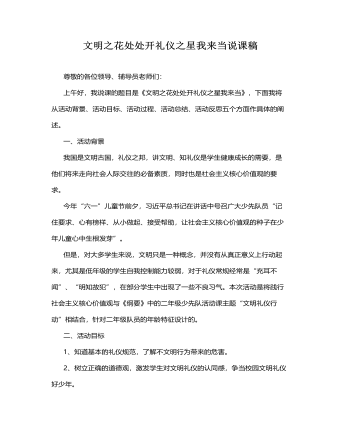
文明之花处处开,礼仪之星我来当说课稿(2)
本次活动,让学生变身“小小侦查员”,调动他们观察发现的积极性,认识到生活中哪些行为是不文明的。运用“新闻直播间”这一新颖的形式,学生在认真聆听讨论之余,知道小小的不文明行为也会造成严重后果。继而通过“情绪体验岛”,引导孩子们在情绪不好的时候,学会自我调整情绪,及时避免不文明行为。最后及时表彰,鼓励其他队员以他们为榜样,使活动主题得以升华。在这一系列充满童趣,层层深入的活动中,同学们表现出了很高的积极性,平时的一言一行都有意识地按文明礼仪的要求做,班风也有了进一步提高。在充分肯定成绩的同时,我们也认识到,不仅要常常开展校园文明礼仪活动,还要开展家庭文明礼仪活动及社会文明礼仪活动,让文明礼仪之花不仅在学校开放,还要开放到家庭、开放到社会,营造出一片人人都讲文明知礼仪的氛围。
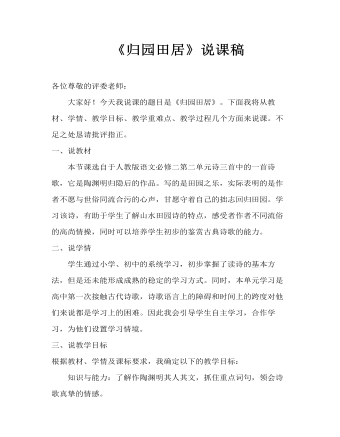
高中语文人教版必修二《归园田居》说课稿
一、说教材本节课选自于人教版语文必修二第二单元诗三首中的一首诗歌,它是陶渊明归隐后的作品。写的是田园之乐,实际表明的是作者不愿与世俗同流合污的心声,甘愿守着自己的拙志回归田园。学习该诗,有助于学生了解山水田园诗的特点,感受者作者不同流俗的高尚情操,同时可以培养学生初步的鉴赏古典诗歌的能力。

初中英语外研版七年级下册《Module 5 Shopping》说课稿
二、教学目标1.知识与技能掌握下列单词:market, supermarket,biscuit, lemon, strawberry, Mother’s Day, size, take, may, try, try on,certainly, wait a minute, sale, price, sale, look. fresh2.过程与方法:1. 能够通过书面表达购物。2. 能够根据情景进行购物对话。3.情感态度与价值观:乐于参加运用英语的实践活动,了解别国文化。三、学习者特征分析这一模块内容的学习者,是七年级的学生。学生已经学过一些形式的特殊疑问句,像what can I do for you?/can I help you?这些购物句式 ,学生在学生在小学阶段已经学过,学生通过阅读,情景购物对话的练习,学生准确的进行购物的对话。
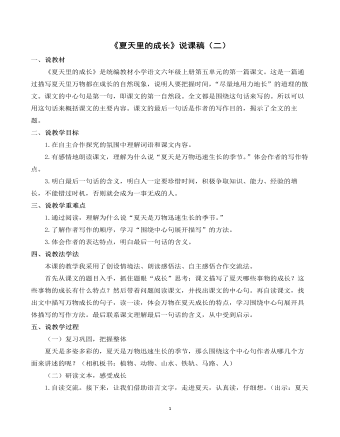
部编人教版六年级上册《夏天里的成长》说课稿(二)
3.明白最后一句话的含义,明白人一定要珍惜时间,积极争取知识、能力、经验的增长,不能错过时机,否则就会成为一事无成的人。 三、说教学重难点1.通过阅读,理解为什么说“夏天是万物迅速生长的季节。” 2.了解作者写作的顺序,学习“围绕中心句展开描写”的方法。 3.体会作者的表达特点,明白最后一句话的含义。四、说教法学法 本课的教学我采用了创设情境法、朗读感悟法、自主感悟合作交流法。首先从课文的题目入手,抓住题眼“成长”思考:课文描写了夏天哪些事物的成长?这些事物的成长有什么特点?然后带着问题阅读课文,并找出课文的中心句。再自读课文,找出文中描写万物成长的句子,读一读,体会万物在夏天成长的特点,学习围绕中心句展开具体描写的写作方法。最后联系课文理解最后一句话的含义,从中受到启示。
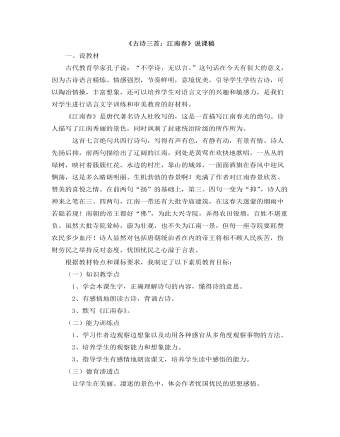
部编人教版六年级上册《古诗三首:江南春》 说课稿
在这样的情境下,学生情趣盎然,紧接着把学生带进新课,点击课件出示配景诗《江南春》,板书课题,齐读课题。接着检查学生的预习情况,每一上新课之前,我都要求学生进行预习,以此来培养学生独立自学能力和良好的学习习惯。然后让学生尝试说说,从题目中,你知道了什么?或你想知道什么?根据学生所说的和所提的,老师归纳总结出有价值的内容和问题,以便在学习古诗中深入渗透探究解决问题。(二)知诗人,介绍写作背景让学生把课前收集到的资料对诗人进行简介及介绍写作背景。这样不仅可以培养其收集处理信息的能力,又培养了口头表达能力及听说能力,又为理解古诗内容做好了准备,同时帮助其获取成功的体验,培养他们主动学习的品质。

部编人教版六年级上册《文言文二则》说课稿
三、说教学重难点1.能正确、流利地朗读课文,背诵《伯牙鼓琴》;能借助注释了解故事大意,并用自己的话讲故事,能从故事中得到启示;理解“伯牙破琴绝弦,终身不复鼓琴,以为世无足复为鼓琴者”的意思。2.结合“资料袋”和同学交流感受。四、说教法学法 科学合理的教学方法能使教学效果事半功倍,达到教与学的完美统一。 本课的教学主要采用情境感悟法、点拨引领法、诵读体悟法。新课标倡导把学习的主动权交给学生,强调学生是学习和发展的主体。诵读是解读文言文的敲门砖。学习文言文的基本方法是读,学习文言文的最好方法还是读,因此学习本课的主要方法是朗读。让学生反复诵读,在此过程中引导学生读思议相结合,同时,指导学生的自主合作探究,让学生的主体地位体现在从提出问题到探究问题,解决问题的过程中。
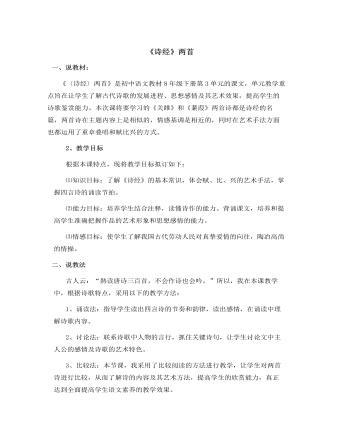
部编版语文八年级下册《诗经》二首 说课稿
一、说教材: 《〈诗经〉两首》是初中语文教材8年级下册第3单元的课文,单元教学重点旨在让学生了解古代诗歌的发展进程、思想感情及其艺术效果,提高学生的诗歌鉴赏能力。本次课将要学习的《关雎》和《蒹葭》两首诗都是诗经的名篇,两首诗在主题内容上是相似的,情感基调是相近的,同时在艺术手法方面也都运用了重章叠唱和赋比兴的方式。 2、教学目标根据本课特点,现将教学目标拟订如下:⑴知识目标:了解《诗经》的基本常识,体会赋、比、兴的艺术手法,掌握四言诗的诵读节拍。⑵能力目标:培养学生结合注释,读懂诗作的能力。背诵课文,培养和提高学生准确把握作品的艺术形象和思想感情的能力。⑶情感目标:使学生了解我国古代劳动人民对真挚爱情的向往,陶冶高尚的情操。
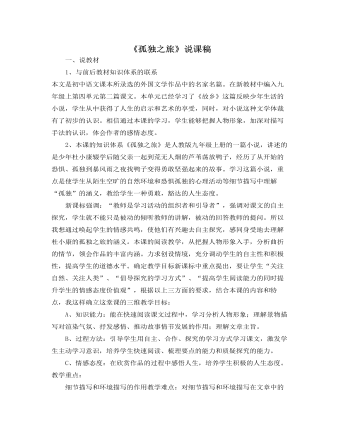
部编版语文九年级上册《孤独之旅》说课稿
二、说教法:我在设计这节课时努力实践新课程理念,充分突出学生的主体地位选择教学方法,整堂课以“在情节与现实写照中得到情感体验”为教学主线,通过整体感知,情节领悟,细节品味等途径,运用快速阅读,自主合作探究等方法,引导学生深入文本,感受主旨,与文章对话,与自己对话,与同学老师对话,在这种感受,体验、交流的课堂学习过程中逐步提升情感态度价值观。三、说学法:采用“自主、合作、探究”的学习方式,让学生自主进入文本,读出感受,通过小组合作交流探究来解决问题。【二·三理论依据】教学过程必须根据学生语文学习的特点,关注学生的个体的学习需求,爱护学生的好奇心,求知欲,充分激发学生的主动意识,倡导自主、合作、探究的学习方式,有助于学生学习方式的形成。

人教版高中语文必修1《纪念刘和珍君》说课稿3篇
1.说教材《记念刘和珍君》是鲁迅先生用饱醮着热泪,用悲愤的笔调写下的一篇感人至深的散文,既有对爱国青年沉痛的悼念,又有对反动派愤怒的控诉,也有对觉醒的国民的呐喊。《记念刘和珍君》是高中语文必修1第三单元第一课的讲读课文。文中描摹人物的音容笑貌,叙述人物的行为事迹,都融入了作者真挚的情感和深刻的感悟。对学生明辨是非,领悟时代精神和人生意义,有着重要的作用。新课标强调了要全面提升高中学生的语文素养,初步形成正确的世界观、人生观、价值观,并学会收集、判断、处理信息,具有人文素养、创新精神与实践能力。同时,《记念刘和珍君》感情真挚,感悟深刻,具有典型人文性。结合本单元教学目标,确立教学目标如下。

人教版高中语文必修2《囚绿记》说课稿2篇
“深入探究,把握主旨”这一步则是解决教学的重点难点,这里涉及到课文的深层意蕴,学生理解有难度,教师在通过问题引领学生探讨的基础上,还要适时启发、点拨,因为教学时间有限,让学生漫无边际的讨论,可能难以完成预定的教学任务,会使教学过程不完整。至于本文的写作特点的教学视时间而定,有时间可以让学生说一说,没有时间用小黑板出示一下,让学生了解就行,如果时间不够,甚至可以不讲。第三阶段是“延伸练习,巩固提高”。

部编人教版三年级上册《大自然的声音》说课稿
四、说教法学法这篇课文浅显易懂、生动有趣,在教学中应以读为本,应让学生在主动积极的思维和情感活动中,加深理解和体验,有所感悟和思考,受到情感熏陶,获得思想启迪,享受审美乐趣。因此,在教学中,引导学生入境、想象、美读、感悟,引导学生在读中感悟,在读中激情,在读中体验、品味,让学生真正走进大自然,体验大自然,发现大自然,激发学生热爱大自然的感情。 1.创设情境,走进文本:在教学中,要让学生自己阅读、自己学会阅读。教学中我创设了情境,让大自然带领学生聆听了一场特殊的音乐会,缩短了学生与文本的空间距离,让学生置身于自然之中,俨然是大自然中的一员,在情境中感知,体会到大自然声音的美妙,与文本产生了共鸣,激发了学生的学习兴趣,让学生成为学习的主人。 2.美读感悟,放飞想象:在教学中始终以“大自然中这些声音真是太美妙了”贯串始终,重点指导学生美读课文,抓住描写声音的词,边读边思考,大胆的展开想象,有感情地读,配乐读,自由读,分组读,师生合读,全班齐读,在读中生成自己独特的感受、体验和理解,感受风声的美妙,水声的有趣,动物声的快乐,同时培养学生的语感。 3.拓展延伸,提高能力:布置学生课后在大自然找一些新发现,拓展学生的学习空间,扩大视野,增长知识。让学生在课内外的学习中提高语文素养。
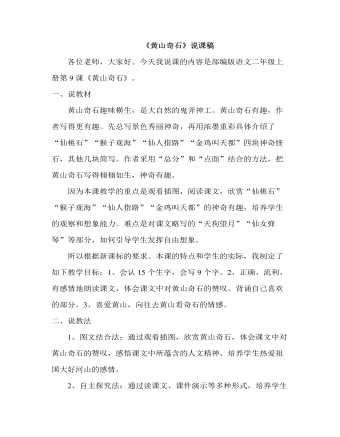
部编人教版二年级上册《黄山奇石》说课稿
二、说教法1、图文结合法:通过观看插图,欣赏黄山奇石,体会课文中对黄山奇石的赞叹,感悟课文中所蕴含的人文精神,培养学生热爱祖国大好河山的感情。2、自主探究法:通过读课文、课件演示等多种形式,培养学生的观察能力和想象能力,激发学生的好奇心与求知欲,引导学生自主探究学习,感受课文的语言美,积累丰富的词汇。三、说学法1、朗读感悟法。开展多种形式的读,如初读、精读、赏读、个别读等,让学生在读中入情入境,在读中整体感知,在读中培养语感,在读中受到情感的熏陶,使教师、学生、文本三者的情感产生共鸣。 2、情境体验法。根据低年级学生注意力集中时间短,抽象思维弱,形象思维占优势的特点,运用形象、直观的教学手段,突破本课的重点和难点。
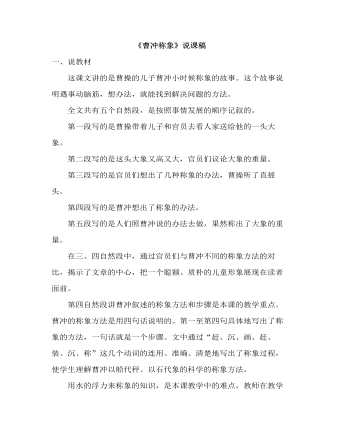
部编人教版二年级上册《曹冲称象》说课稿
全文共有五个自然段,是按照事情发展的顺序记叙的。第一段写的是曹操带着儿子和官员去看人家送给他的一头大象。第二段写的是这头大象又高又大,官员们议论大象的重量。第三段写的是官员们想出了几种称象的办法,曹操听了直摇头。第四段写的是曹冲想出了称象的办法。第五段写的是人们照曹冲说的办法去做,果然称出了大象的重量。在三、四自然段中,通过官员们与曹冲不同的称象方法的对比,揭示了文章的中心,把一个聪颖、质朴的儿童形象展现在读者面前。第四自然段讲曹冲叙述的称象方法和步骤是本课的教学重点。曹冲的称象方法是用四句话说明的。第一至第四句具体地写出了称象的方法,一句话就是一个步骤。文中通过“赶、沉、画、赶、装、沉、称”这几个动词的连用、准确、清楚地写出了称象过程,使学生理解曹冲以船代秤、以石代象的科学的称象方法。用水的浮力来称象的知识,是本课教学中的难点,教师在教学中要努力使文章中抽象的语言文字具体化,以帮助学生理解曹冲称象的具体方法和步骤。
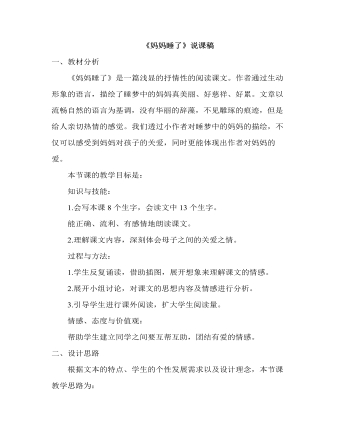
部编人教版二年级上册《妈妈睡了》说课稿
一、教材分析《妈妈睡了》是一篇浅显的抒情性的阅读课文。作者通过生动形象的语言,描绘了睡梦中的妈妈真美丽、好慈祥、好累。文章以流畅自然的语言为基调,没有华丽的辞藻,不见雕琢的痕迹,但是给人亲切热情的感觉。我们透过小作者对睡梦中的妈妈的描绘,不仅可以感受到妈妈对孩子的关爱,同时更能体现出作者对妈妈的爱。本节课的教学目标是:知识与技能:1.会写本课8个生字,会读文中13个生字。能正确、流利、有感情地朗读课文。2.理解课文内容,深刻体会母子之间的关爱之情。过程与方法:1.学生反复诵读,借助插图,展开想象来理解课文的情感。2.展开小组讨论,对课文的思想内容及情感进行分析。3.引导学生进行课外阅读,扩大学生阅读量。情感、态度与价值观:帮助学生建立同学之间要互帮互助,团结有爱的情感。
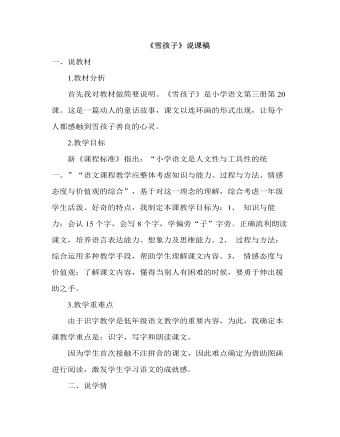
部编人教版二年级上册《雪孩子》说课稿
1.教材分析首先我对教材做简要说明。《雪孩子》是小学语文第三册第20课。这是一篇动人的童话故事,课文以连环画的形式出现,让每个人都感触到雪孩子善良的心灵。2.教学目标新《课程标准》指出:“小学语文是人文性与工具性的统一。”“语文课程教学应整体考虑知识与能力、过程与方法、情感态度与价值观的综合”,基于对这一理念的理解,综合考虑一年级学生活泼、好奇的特点,我制定本课教学目标为:1、 知识与能力:会认15个字,会写8个字,学偏旁“子”字旁。正确流利朗读课文,培养语言表达能力、想象力及思维能力。2、 过程与方法:综合运用多种教学手段,帮助学生理解课文内容。3、 情感态度与价值观:了解课文内容,懂得当别人有困难的时候,要勇于伸出援助之手。


